Were Creek Indians from West Mexico?
Searching for the Mountain of Fire (Volcano)
Here are the known eruptions in the western USA according to USGS data from 1200 AD and before[xxii]:
| Name, Location | Last Eruption |
| Mount Adams, Washington | 500 BC +- 1000 years |
| Mount Washington, Oregon | 670 AD |
| Mount Jefferson, Oregon | 950 AD |
| Blue Lake Crater, Oregon | 680 AD +-200 years |
| Belknap Crater, Oregon | 460 AD |
| Sunset Crater, Arizona | 1122 AD +- 58 years |
| Medicine Lake Volcano, California | 1080 +-25 years |
Eruptions in the Pacific Northwest including northern California are unlikely candidates since the cultural traditions of the Muskogee-Creek do not match anything in that area. This leaves Arizona as the most likely candidate yet the Sunset Crater eruption in this area occurred after 1019 AD. Also, the eruption actually created the cone of the volcano. Before the eruption there was simply a crater or caldera and thus no “mountain” which to climb. Therefore with no suitable eruption in the right time period in the U.S. we must look for volcanic eruptions in Mexico. Here are the known eruptions in northern and central Mexico according to USGS data from 1200 AD and before:
| Name, Location | Eruptions |
| Ceboruco Volcano, Nayarit | 930 AD +-200[xxiii] (Ongoing since) |
| Colima Volcano, Colima & Jalisco | Most active in Mexico- ongoing |
| Popocatepetl | 800 AD (last major eruption) |
| Pico de Orizaba | ongoing |
Of the volcanoes listed, Ceboruco and Colima are both in the same geographical areas as the artifacts from the western Mexican shaft tomb tradition. The Ceboruco eruption between 730-1130 AD is within the right time frame for a migration from this location to reach the southeastern U.S. by 1019 AD. (The migration of the Aztec from their homeland into central Mexico is thought to have taken 320 years, by comparison.) This eruption was also the largest in Mexico in the past 10,000 years[xxiv] causing devastation to an area over 500 square kilometers.[xxv] This eruption would have certainly been preceded by earthquake activity and its size would certainly have inspired people to move from the region. Thus the Ceboruco volcano is a good candidate.
To reach Spiro and the Caddoan Mississippian Culture Area in Texas, Oklahoma, Arkansas and Louisiana one would have to travel northeast from Ceboruco. The sun appears to rise from the northeast during the summer months[xxvi] and is at its most extreme northeastern position on the summer’s solstice around June 21.[xxvii] Since the migration says they were heading towards the sunrise it is likely this was the time of year they set out.
There is another possibility. The migration legend states they headed toward the sunrise and then reached the volcano. There is no directional evidence after this point in the legend except that they mixed the fire from the volcano with fire that came from the north.
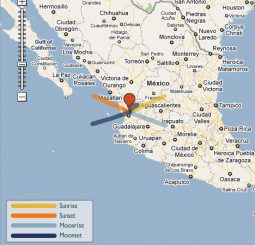 |
| Yellow line shows direction of sunrise (NE) on June 21 from Nayarit, Mexico. (Image produced with The Photographer’s Ephemeris software.) |
The Creeks called themselves the People of One Fire. In Creek Indian tradition, the idea of mixing of fire is the same as mixing of people. Thus it is possible that the reference in the migration legend to mixing of fire from the volcano with fire that came from the north suggests they migrated north from Ceboruco and mixed with a new people. The preponderance of the evidence supports this conclusion as we will see.
View larger map |
| Map showing (A) Mount Ceboruco in Nayarit, Mexico and (B) Pueblo Bonito at Chaco Canyon in New Mexico and (C) Spiro Mounds in Oklahoma. |
Can the Creek Migration Legends be Trusted?
Of course, all of the preceding evidence is conditional to the accuracy of the migration legends. Is there any evidence that may help confirm the reliability of these ancient oral traditions? Creek Indian tradition maintains that the Ocmulgee Mounds site in Macon, Georgia was the site where they “first sat down” after their long migration from the west.
Additionally, the migration legends of this tribe were all recorded between the early 1700s and 1800s long before any archaeological investigations took place at the Ocmulgee Mounds site in the 1930s. Thus, if the archaeological data from the 1930s matched data in the migration legends recorded a century or two earlier, this would provide strong corroboration as to the reliability of these legends.
In fact, there are many pieces of evidence uncovered at the Ocmulgee Mounds site that corroborate information in the migration legend. The migration legend mentions that Ocmulgee was originally inhabited by a race of “flathead” Indians whom they massacred upon arriving in order to take over the town. Archaeologists noted that the burials in the lowest part of the burial mound showed signs of cranial deformation while burials in the upper levels did not.[xxviii] This supports the idea that the people who practiced cranial deformation were replaced by a people who did not.
The legend also states that on their journey eastward towards the sunrise they encountered a man-eating large cat, i.e. a panther, which they killed. They kept the bones of this cat and would take them into battle with them to assure success. Archaeologists uncovered a headdress in one burial that was made from the jawbones of two panthers and featured two copper ornaments embossed with a rising sun. Both of these pieces of evidence seem to support these details of the migration legend.
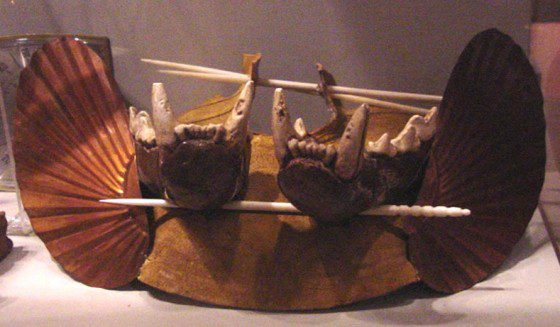 |
| Headdress found in Ocmulgee Mounds Funeral Mound |
Finally, as mentioned previously, the migration legend states that the first structure they built at Ocmulgee Mounds was a “mound with a central chamber” which sounds remarkably similar to the earth lodge discovered by A. R. Kelly in 1938.
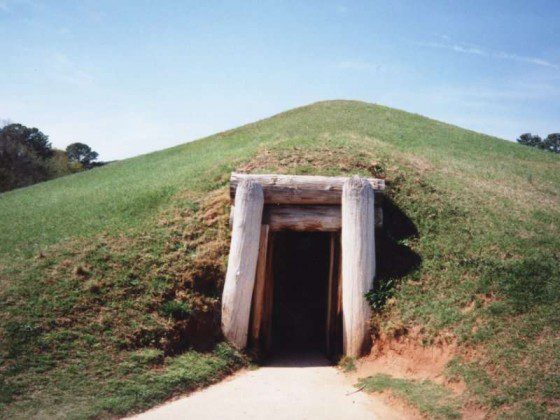 |
| Ocmulgee Earth Lodge which is a “mound with a central chamber” as described in the migration legend |
Archaeologist Lewis Larson noted that the 19th century researcher Swanton “provided the most detailed and exhaustive survey of the ethnohistorical literature covering the domestic and public architecture of the southeastern Indians. A review of his survey reveals that there are no structures comparable to the Macon Plateau earth lodge as it has been described by Kelly….”[xxix]
In other words, during the time period that the migration legends were recorded, no known structure similar to an earth lodge was in existence thus: 1) how could a Native American informant at this time describe such a structure and 2) how could the description of this structure match perfectly with the archaeological data from excavations conducted nearly 200 years after the legend was recorded? Either the informant in question was psychic or the legend is an accurate recounting of real historical events.

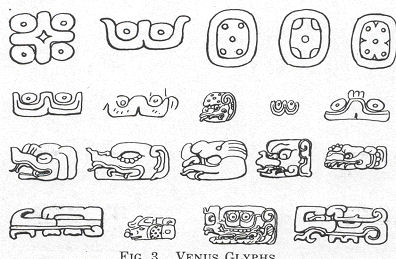

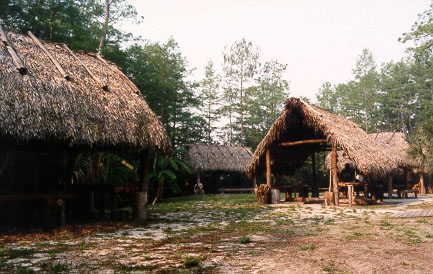
Very fascinating discourse! Results from my STR ancestry DNA calculator confirm the Mexico/southeast U.S. migration with the the Cora people of Nayarit being directly related to the Creek Indians of Georgia.